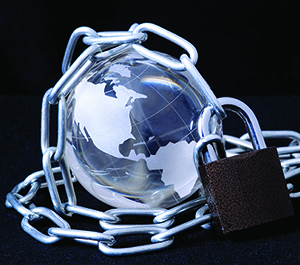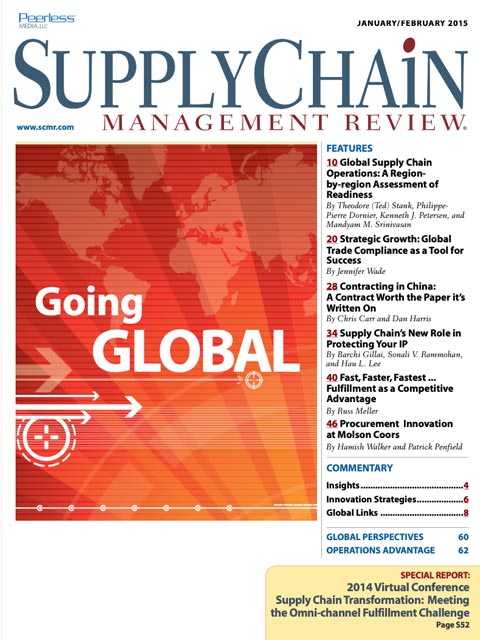Sorry, but your login has failed. Please recheck your login information and resubmit. If your subscription has expired, renew here.
January-February 2015
As long as there have been boats and beasts of burden, intrepid business professionals, governments, and marauders have sought fame, fortune, wealth, and value by going global. Think the Phoenicians, Marco Polo, and the Vikings in days of old. Or in contemporary times, think of China, BRIC, EMEA, and other emerging markets. One could argue that outsourcing to China a few decades ago gave birth to supply chain management as we think of it today. This month we’re including an online bonus column from APQC. While this issue focuses on global management, we didn’t want to miss out on the column. Browse this issue archive.Need Help? Contact customer service 847-559-7581 More options
Intellectual property (IP) has become the coin of the realm over the last few decades. In a knowledge-based economy, organizations are creating value through creations of the human mind, which can be commercially used, and may take the form of copyrights, patents, trademarks, registered designs, and trade secrets. By some estimates, as much as 75 percent of most organizations’ value and revenue sources are in intangible assets, IP, and proprietary competitive advantages. Yet, the importance of IP is often overlooked by the supply chain.
While firms are adopting a more holistic approach to addressing social, environmental, and ethical issues, IP protection is rarely considered part of this approach at an operational level. Instead, IP protection is often managed by the legal department, with most companies failing to take effective strategic and operational action to lower their litigation risk and improve the likelihood of keeping their IP secure. In fact, a 2012 survey conducted by the Center for Responsible Enterprise and Trade (CREATe) with the Conference Board of Canada found that for 93 percent of surveyed companies, the legal department had primary responsibility for IP protection. Yet the same survey highlighted a lack of confidence in this traditional approach and a lack of results. Another hurdle limiting the effectiveness of IP protection strategies is the tendency of firms to operate in silos, with different organizational units determining their own IP strategy.
Given the shortcomings of common strategies, it is not surprising that IP rights violations and the lack of enforcement are widespread, creating a serious problem for multinational firms. The magnitude of the problem has been especially significant in China, where in 2011 the software piracy rate for personal computers was 77 percent. The commercial value of this unlicensed software was US $8.902 billion, according to the 2011 BSA Global Software Piracy Study. The impacts of other IP violations are even higher. A 2013 report of the Commission on the Theft of American Intellectual Property estimates the scale of American IP theft reaches over US $300 billion per year. The International Chamber of Commerce estimated the global economic and social impacts of counterfeit and pirated products at about US $775 billion in 2008; this was estimated to more than double to US $1.7 trillion by 2015. In addition to financial losses, illicit activities harm company brands and reputations. And at a higher level, IP theft is undermining both the means and incentives for entrepreneurs to innovate, which can slow the development of new inventions and industries, impeding growth.
 |
This complete article is available to subscribers
only. Click on Log In Now at the top of this article for full access. Or, Start your PLUS+ subscription for instant access. |
SC
MR
Sorry, but your login has failed. Please recheck your login information and resubmit. If your subscription has expired, renew here.
January-February 2015
As long as there have been boats and beasts of burden, intrepid business professionals, governments, and marauders have sought fame, fortune, wealth, and value by going global. Think the Phoenicians, Marco Polo, and… Browse this issue archive. Access your online digital edition. Download a PDF file of the January-February 2015 issue.
 |
Download Article PDF |
Intellectual property (IP) has become the coin of the realm over the last few decades. In a knowledge-based economy, organizations are creating value through creations of the human mind, which can be commercially used, and may take the form of copyrights, patents, trademarks, registered designs, and trade secrets. By some estimates, as much as 75 percent of most organizations’ value and revenue sources are in intangible assets, IP, and proprietary competitive advantages. Yet, the importance of IP is often overlooked by the supply chain.
While firms are adopting a more holistic approach to addressing social, environmental, and ethical issues, IP protection is rarely considered part of this approach at an operational level. Instead, IP protection is often managed by the legal department, with most companies failing to take effective strategic and operational action to lower their litigation risk and improve the likelihood of keeping their IP secure. In fact, a 2012 survey conducted by the Center for Responsible Enterprise and Trade (CREATe) with the Conference Board of Canada found that for 93 percent of surveyed companies, the legal department had primary responsibility for IP protection. Yet the same survey highlighted a lack of confidence in this traditional approach and a lack of results. Another hurdle limiting the effectiveness of IP protection strategies is the tendency of firms to operate in silos, with different organizational units determining their own IP strategy.
Given the shortcomings of common strategies, it is not surprising that IP rights violations and the lack of enforcement are widespread, creating a serious problem for multinational firms. The magnitude of the problem has been especially significant in China, where in 2011 the software piracy rate for personal computers was 77 percent. The commercial value of this unlicensed software was US $8.902 billion, according to the 2011 BSA Global Software Piracy Study. The impacts of other IP violations are even higher. A 2013 report of the Commission on the Theft of American Intellectual Property estimates the scale of American IP theft reaches over US $300 billion per year. The International Chamber of Commerce estimated the global economic and social impacts of counterfeit and pirated products at about US $775 billion in 2008; this was estimated to more than double to US $1.7 trillion by 2015. In addition to financial losses, illicit activities harm company brands and reputations. And at a higher level, IP theft is undermining both the means and incentives for entrepreneurs to innovate, which can slow the development of new inventions and industries, impeding growth.
 |
SUBSCRIBERS: Click here to download PDF of the full article. |
SC
MR


Latest Supply Chain News
- Despite American political environment, global geopolitical risks may be easing
- Joseph Esteves named CEO of SGS Maine Pointe
- Employees, employers hold divergent views on upskilling the workforce
- April manufacturing output slides after growing in March
- Q1 sees a solid finish with positive U.S.-bound import growth, notes S&P Global Market Intelligence
- More News
Latest Podcast

 Explore
Explore
Latest Supply Chain News
- Despite American political environment, global geopolitical risks may be easing
- Joseph Esteves named CEO of SGS Maine Pointe
- Employees, employers hold divergent views on upskilling the workforce
- April manufacturing output slides after growing in March
- Q1 sees a solid finish with positive U.S.-bound import growth, notes S&P Global Market Intelligence
- World Trade Centers offers a helping hand to create resilient, interconnected supply chains
- More latest news
Latest Resources

Subscribe

Supply Chain Management Review delivers the best industry content.

Editors’ Picks





